
Have you ever gazed at the night sky and wondered about those magical, dancing lights? The Northern Lights, or Aurora Borealis, are a natural light display in the Earth's sky, predominantly seen in high-latitude regions around the Arctic. These lights are caused by particles from the sun colliding with gases in Earth's atmosphere, creating stunning colors like green, pink, and purple. Best viewed in places like Norway, Iceland, and Canada, these lights have fascinated humans for centuries. Legends and myths surround them, with some cultures believing they are spirits or omens. Scientists study them to understand solar activity and its effects on Earth. Whether you're a science enthusiast or a dreamer, the Northern Lights offer a spectacle that captivates all who witness them. Ready to learn more about this breathtaking phenomenon? Let's dive into 21 fascinating facts about the Northern Lights!
What Are the Northern Lights?
The Northern Lights, also known as the aurora borealis, are a natural light display in the Earth's sky. They are predominantly seen in high-latitude regions around the Arctic and Antarctic. These lights are a mesmerizing phenomenon that has fascinated people for centuries.
-
Aurora Borealis is the scientific name for the Northern Lights. The term "aurora" comes from the Roman goddess of dawn, and "borealis" means "northern" in Latin.
-
Solar Wind is responsible for creating the Northern Lights. Charged particles from the sun collide with gases in Earth's atmosphere, causing the beautiful light displays.
-
Colors of the aurora can vary. Green is the most common, but pink, red, yellow, blue, and violet can also appear, depending on the type of gas particles involved.
Where Can You See the Northern Lights?
These lights are best viewed in places near the magnetic poles. The further north you go, the better your chances of witnessing this stunning spectacle.
-
Norway is one of the best places to see the Northern Lights. Tromsø, in particular, is a popular spot for aurora hunters.
-
Iceland offers incredible views of the aurora borealis. Its remote locations and dark skies make it an ideal destination.
-
Canada also provides excellent opportunities to see the lights, especially in the Yukon, Northwest Territories, and Nunavut.
When Is the Best Time to See the Northern Lights?
Timing is crucial for catching a glimpse of the Northern Lights. Certain months and conditions increase the likelihood of seeing them.
-
Winter Months are the best time to see the Northern Lights. Longer nights and clear skies improve visibility.
-
Equinoxes in March and September are peak times for aurora activity. The Earth's position relative to the sun during these periods enhances the chances of seeing the lights.
-
Dark Skies are essential. Light pollution from cities can hinder your view, so it's best to find a remote location.
How Do the Northern Lights Affect Us?
The Northern Lights are not just a visual treat; they also have scientific and cultural significance.
-
Magnetic Field interactions cause the auroras. These interactions can sometimes affect satellite communications and GPS systems.
-
Cultural Significance varies across different societies. Many indigenous cultures have myths and legends about the aurora, often viewing them as spiritual phenomena.
-
Scientific Research on the Northern Lights helps scientists understand more about Earth's magnetic field and solar activity.
Fun Facts About the Northern Lights
There's more to the Northern Lights than meets the eye. Here are some intriguing tidbits about this natural wonder.
-
Southern Lights or aurora australis occur in the Southern Hemisphere. They are the counterpart to the Northern Lights.
-
Aurora Sounds have been reported by some observers. These faint sounds are still a mystery to scientists.
-
Space Weather can influence the intensity and frequency of the auroras. Solar storms can lead to more vibrant displays.
-
Aurora Oval is the ring-shaped region around the magnetic poles where auroras are most likely to occur.
-
First Recorded Observation of the Northern Lights dates back to 2600 BC in China. Ancient texts describe the phenomenon.
-
NASA has launched missions to study the auroras. These missions aim to gather data on how solar winds interact with Earth's atmosphere.
-
Aurora Photography has become a popular hobby. Capturing the lights requires patience and skill, but the results are breathtaking.
-
Aurora Tourism is a growing industry. Many travel companies offer tours specifically designed to help people see the Northern Lights.
-
Aurora Forecasts are available online. These forecasts predict the likelihood of aurora activity, helping enthusiasts plan their trips.
The Magic of the Northern Lights
Northern Lights, or Aurora Borealis, are one of nature's most stunning displays. These lights are caused by solar particles colliding with Earth's atmosphere, creating vibrant colors in the sky. They can be seen in places like Norway, Iceland, and Canada, especially during winter months when nights are longer. The best time to catch this spectacle is between September and March.
These lights have inspired countless myths and legends, from ancient tales of sky warriors to spirits dancing in the heavens. Modern technology allows us to predict when and where they'll appear, but their beauty remains unpredictable and awe-inspiring.
Whether you're a seasoned traveler or just curious, witnessing the Northern Lights is a bucket-list experience. So, if you ever get the chance, grab a warm coat, head north, and look up. The sky might just surprise you.
Was this page helpful?
Our commitment to delivering trustworthy and engaging content is at the heart of what we do. Each fact on our site is contributed by real users like you, bringing a wealth of diverse insights and information. To ensure the highest standards of accuracy and reliability, our dedicated editors meticulously review each submission. This process guarantees that the facts we share are not only fascinating but also credible. Trust in our commitment to quality and authenticity as you explore and learn with us.


